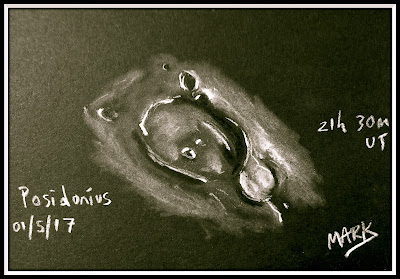 |
| Screenshot of Mercury from WinJUPOS software March 16th 2018 - 19h15mUT |
The sky was full of lingering clouds, big black Venus and Mercury obscuring clouds!
It took a little time for my cloudbusting to work, but finally the bulk of the cloud parted to reveal a brilliant Venus, and just above and slightly to the right a glorious and very welcome Mercury.
It must be three years since I last spotted the winged messenger.
Due to the often cumulus filled horizons of this county and probably most counties in the United Kingdom, Mercury remains hidden from view for much of its possible observing season.
To the southwest a cloud bank was moving ominously westward, by the look of the formation I had maybe a five minute window to catch a peep of this fiery Sun hugging planet.
The Maksutov came to mind, light weight, portable and easy to set up.
Setting up on the garden bench was easy, with a 10mm eyepiece in place, red dot finder trained , I was up and observing in about two minutes total.
Mercury had about it an obvious crescent phase
As it happened I managed a whole ten minutes of planet peeping.
Even though, it was worth the mad rush of setting up the telescope. It’s often like this in Pembrokeshire.
If I see the gaps in the sky, I have to rush and grab the telescope, hesitate and all is usually lost for the night!
Even though, it was worth the mad rush of setting up the telescope. It’s often like this in Pembrokeshire.
If I see the gaps in the sky, I have to rush and grab the telescope, hesitate and all is usually lost for the night!
Yet another reason to own a “grab and go” telescope.





















































